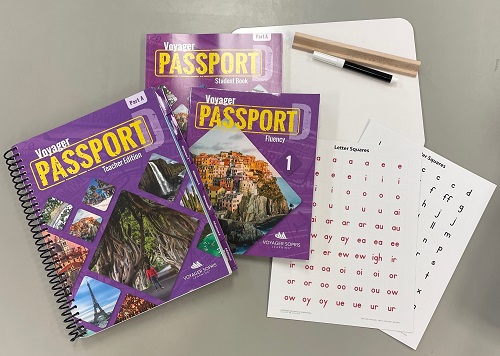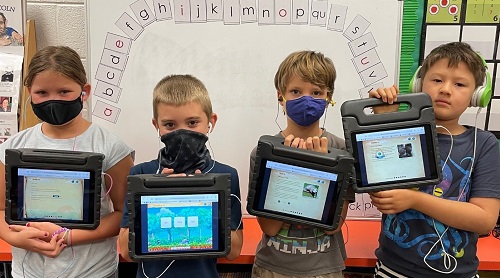Elementary Literacy Intervention: What You Need to Know This School Year
Learn More About Voyager Passport
The simple view of reading states that reading comprehension is the product of word recognition and language comprehension. This simple, yet powerful, equation informs both my beginning-of-the-year assessments and the reading interventions I provide for my third-grade students. Since my end goal is reading comprehension, I need to assess and support my students in both their word-recognition skills and their language comprehension abilities
One of the very first things I do each school year is collect beginning-of-the-year data using Acadience® Reading. Acadience is a universal-screening tool that provides a snapshot of students’ literacy skills and helps to identify students who may be at risk for reading difficulties. In third grade, all of my students take the Oral Reading Fluency (ORF) assessment with the Retell portion as well as the Maze, a reading-comprehension assessment.
When looking at my class Acadience data, I start with student scores on the Oral Reading Fluency (ORF) assessment. I want to see which students are below benchmark for correct words per minute, accuracy, or both. These are my students who will need an intervention plan focused on word recognition. I also give these students other diagnostic assessments to check on their phonological and phonics skills. This gives me a sense of which foundational skills are the most important for small-group intervention. My personal favorites are David Kilpatrick’s Phonological Awareness Screening Test (PAST) and the LETRS® Phonics and Word-Reading Survey.
After identifying students who will need support with word-recognition skills, I shift my attention to the comprehension pieces of the Acadience screener. It can be easy to focus all of our intervention attention on word-recognition skills since they are so essential for our beginning readers. But we cannot neglect the language comprehension side of the simple view of reading equation. Looking at my students’ retell scores and their scores on the Maze helps me identify those who may struggle with comprehension. It is important to recognize that a snapshot cannot give detailed information about a student’s specific language or reading comprehension abilities. However, if a student scores below benchmark in these areas, it should put them on your radar so you can explore their comprehension.

Examining beginning-of-the-year data can be time consuming and challenging. However, when I look closely at my Acadience and other diagnostic data, I can make informed decisions about what my students will need during small-group reading time. I can see natural groupings of students that start to emerge and suggest appropriate intervention. This data analysis helped me to choose which students would benefit most from the Voyager Passport® intervention I am using this year. Voyager Passport is designed for students about one to one-and-a-half years below grade level. It will be best suited for my students who need support in both word recognition and language comprehension who are showing up in my data as just below benchmark. These are my students who are reading about 40-75 words correct per minute with accuracy scores in the 70%–90% range. They are also scoring poorly on the retell and Maze assessments. But these are also students who are within reach of meeting benchmark goals if they receive the right intervention. The balance of word-recognition skill work and language comprehension practice included in Voyager Passport will be the perfect level of remedial support for these students. I am excited to be using Voyager Passport to help them solidify their word-recognition skills while also surrounding them with meaningful language comprehension experiences. It will be a well-rounded intervention plan for these students and I’m looking forward to using the included progress-monitoring tools to watch them grow.
But as you may be thinking, these students are not the only ones in my classroom. I will have other students who are well below benchmark who need a very intensive intervention plan. I will also have students who are at or above benchmark who will need opportunities to practice and extend their literacy skills. And all of this must be accomplished in one classroom with one teacher. This is where I need to consider the classroom management aspects of small-group instructional time. In other words, what will the other students do while I am teaching in a small group?
This is where Reading Rangers saves the day! I have been using Reading Rangers with my students since the beginning of the year and we are all hooked on this fun and engaging way to practice our literacy skills. And while student engagement is the icing on the cake, I am especially excited about how I can differentiate Reading Rangers to meet the needs of all my students during their independent work time without them knowing their exact level.

Reading Rangers includes phonics and comprehension components in the kindergarten-, first-, and second-grade levels and shifts to just comprehension at the third-, fourth-, and fifth-grade levels. This is an important distinction to keep in mind when placing students in the program. I used the same Acadience data I used to plan intervention groups to help me place students in Reading Rangers. If my students struggled with any aspects of word recognition or comprehension, I started them at a K–2 level. Students who were at or above benchmark started at a third- to fifth-grade level.
Now that beginning-of-the-year assessments are complete and I have made intentional decisions about my students’ literacy needs, my focus will shift to delivering differentiated instruction and monitoring student progress. You can follow our classroom literacy journey on my social media platforms this year!
References:
Moats, L. C., & Tolman, C. A. (2019). LETRS (3rd ed., Vol. 1). Voyager Sopris.
Kilpatrick, D. A. (2021). Equipped for Reading Success. Casey & Kirsch Publishers.



